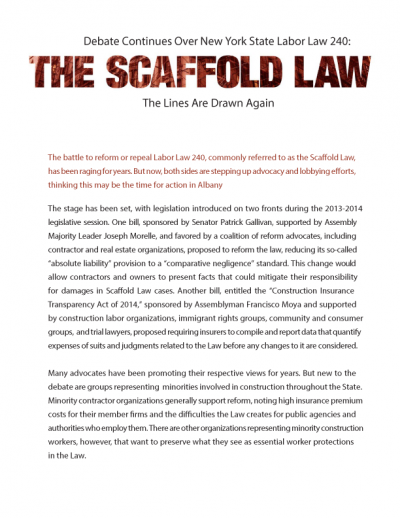
THE SCAFFOLD LAW
IS NEW YORK REALLY ALONE?
Reform advocates argue that no other state has a Scaffold Law as broadly applied as New York's or as costly, in terms of the effect on insurance premiums, jobsite productivity, and economic development. BCTC asserts that, while provisions vary state by state, seven other states have scaffold laws, including some which specifically draw their inspiration from New York's Law. Reformers respond that, if that were the case, the dearth of willing insurers and skyrocketing premiums would be more common, presumably in these other states. But many in development and construction nationwide attest to New York's unique predicament.
A study released in February, The Costs of Labor Law 240 on New York's Economy and Public Infrastructure, commissioned by the nonprofit New York Civil Justice Institute and conducted by researchers at Cornell University and The Nelson A. Rockefeller Institute of Government, University at Albany, State University of New York, finds that New York is the only state in the country to have a law that applies an absolute liability standard, and, based on a preliminary review, no other country has a similar law. The study also finds that redirecting the money spent on lawsuits and insurance to the construction industry would generate an estimated net gain of 12,000 jobs and approximately $480 million in labor income.
However, the website of the labor-backed coalition opposed to Scaffold Law reform notes that this study may have a fatal flaw. An article by Paul Basken of the Chronicle of Higher Education posted on the site describes specific concerns the Rockefeller Institute's director Thomas L. Gais expressed about the report and quotes him in saying that, "The report's analysis suffers from 'really big weaknesses' and that flawed statistical analysis was used to make the 'counterintuitive' argument that New York's worker-safety law actually leaves workers less safe" (www.scaffoldsafetylaw.com).
Mr. Gunn insists that if, instead of reacting to the added liability burden in New York, insurers were unnecessarily hiking premiums and reaping huge profits, as reform opponents imply, there would be numerous companies clamoring to cover construction projects in New York rather than virtually none. He and others advocating reform point to Illinois as an example, noting the costs saved and safety standards maintained after that State repealed its Scaffold Law in 1995. According to BCTC, however, after repeal, Illinois lost construction jobs while over the same period New York added construction jobs.



